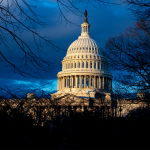WASHINGTON — The U.S. Treasury continues to collect tax revenue during the government shutdown, which began on October 1, 2025, and surpassed the previous record of 35 days on November 5.
Yet critical programs like the Supplemental Nutrition Assistance Program (SNAP) are operating on limited emergency funds rather than regular appropriations, leaving millions of Americans wondering: If the money is there, why can’t the government spend it?
The answer lies in a fundamental constitutional requirement and federal law that prohibits spending without explicit congressional authorization.
“In the absence of an appropriations bill, the government can’t spend money, because it isn’t allowed to do so,” said Eric Chaffee, the John C. Hutchins Professor of Law at Case Western Reserve University.
Constitutional requirements
The Constitution states in Article I, Section 9: “No Money shall be drawn from the Treasury, but in Consequence of Appropriations made by Law.” This means Congress must pass legislation known as appropriations to authorize the government to spend money, even when the government already has the funds available in its Treasury.
The Anti-Deficiency Act, originally passed in the 1800s, reinforces this constitutional mandate. The law “prohibits federal agencies from spending or committing any money without an explicit current appropriation bill,” Chaffee explained.
When Congress fails to pass the necessary spending bills, the government must shut down because continuing to spend money would be unconstitutional and illegal. The current shutdown began when Congress failed to pass appropriations legislation, leaving numerous federal programs without authorization to disburse funds.
During the lapse in spending, federal employees whose salaries depend on annual appropriations must stop working unless they are considered “excepted” workers performing emergency tasks protecting life and property.
Those who are on the job, including air traffic controllers and Transportation Security Administration screeners, won’t be paid for their labor until the shutdown ends and Congress authorizes the expense.
Economic impact
The Congressional Budget Office estimates that the shutdown has delayed $74 billion in federal spending through eight weeks, including compensation for federal employees, purchases of goods and services, and SNAP benefits. Using information from federal agencies’ contingency plans and the Office of Personnel Management, the CBO estimates that about 600,000 employees are working without pay as “excepted” workers, while 650,000 employees have been furloughed.
The economic damage extends beyond the federal workforce.
The CBO projects that the shutdown will reduce annualized real gross domestic product growth in the fourth quarter of 2025 by 2.0 percentage points in an eight-week shutdown scenario. While most economic activity will rebound once funding resumes, the CBO estimates that between $7 billion and $14 billion in economic output will be permanently lost because furloughed employees worked fewer weeks during the shutdown.
The shutdown has also increased the unemployment rate. The Bureau of Labor Statistics counts most furloughed workers as unemployed on temporary layoff. If all furloughed workers in October were counted as unemployed, the measured unemployment rate would increase by 0.4 percentage points that month, according to the CBO analysis.
SNAP benefits on emergency funding
SNAP benefits were fully paid in October. After court action forced the administration to tap into its emergency accounts for November SNAP payments, the administration announced it will pay only a portion of benefits.
During a shutdown, tax revenue continues flowing into government coffers and is there “waiting to be spent,” says Chaffee.
However, that money cannot be touched without congressional action, regardless of how much has accumulated.
Some government functions continue operating because they don’t require annual appropriations bills. These include Social Security and Medicare payments, though processing of new claims face delays.
But programs requiring appropriations, like SNAP, have been forced to rely on limited emergency reserves. The administration has limited authority to use certain pre-approved or emergency funds, such as USDA reserve funds for SNAP, but those accounts are restricted in scope and can only provide temporary, partial relief.
The current shutdown began on October 1, 2025. On November 5, it surpassed the previous record of 35 days — set during the 2018-2019 shutdown during Donald Trump’s first term in office. Government shutdowns are a relatively recent phenomenon, becoming more frequent over the past 40 years, says Chaffee.
“What they tend to reflect is that there’s more gridlock in Washington than what there previously was,” Chaffee said. He noted that in past shutdowns, political parties typically faced enough public pressure to reach a compromise, but “we’re living in such a period of polarization” that “it’s not even clear that this is going to end anytime soon.”
If you purchase a product or register for an account through a link on our site, we may receive compensation. By using this site, you consent to our User Agreement and agree that your clicks, interactions, and personal information may be collected, recorded, and/or stored by us and social media and other third-party partners in accordance with our Privacy Policy.










